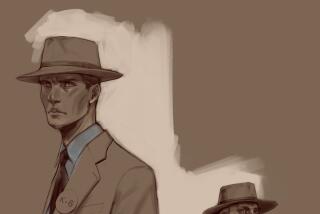When One Woman’s Desire for Fancy Fashion Takes a Fatal Turn
Emma Donoghue based this novel about a harlot’s progress in 18th century England on contemporary accounts of the hanging of a 16-year-old servant girl, Mary Saunders, in 1764 for the murder of her mistress--a crime motivated, so it was said, by her longing for “fine clothes.”
The word “slammerkin,” apparently, referred both to a “loose” woman and to a kind of revealing gown worn by London prostitutes. Then, as now, sartorial imitation went both ways: The prostitutes aspired to look like rich ladies, and the ladies, seeking a bit of street flash, wore slammerkins. Facts about the real Mary Saunders are “disputed and few,” Donoghue notes, so she could make the fictional Mary anything she wanted. And what she wanted, clearly, was a girl whose short, tragic life would prompt her to think about class and gender issues in ways that her time would call subversive but that we would recognize as modern.
Donoghue (“Passions Between Women,” “Stir-fry,” “Kissing the Witch”) is a vivid storyteller, and her prose is free of anachronisms, but we might question this approach to the historical novel. It’s the popular way to write one--finding signs of our own time in the costume-drama of the past--but does it bring the past to life as it really was?
The harder but more interesting approach was demonstrated by John Fowles in “The French Lieutenant’s Woman” and “A Maggot.” The point of those novels was that the English of only a century or two ago were almost unimaginably different from us. The language we share with them, no matter how much literary fashions have changed, conceals a far greater change in our basic mental furniture. The past, Fowles argued, resists our every attempt to cozy up to it.
Donoghue’s Mary is a bright, ambitious girl whose options in the 1760s are severely limited. Her father is dead; her mother is a low-grade seamstress who lives in a dingy London cellar. Mary is lucky enough to attend a “charity school” and learn to read, write and figure, but education isn’t likely to alter her fate: wearing drab homespun, marrying, having babies and plying her needle until her eyes give out.
What does alter it is disaster: a sexual encounter with a ribbon peddler whose wares Mary covets. She gets pregnant at 14. Her mother and stepfather disown her. She is gang-raped by soldiers. She contracts gonorrhea. She has an abortion. Her only refuge is with a kindly whore, Doll Higgins, who teaches her the streetwalker’s trade and extols the jaunty “liberty” of it, though gin, disease and ill-use make most streetwalkers old at 20.
Two opportunities of escape present themselves--on the terms the 1760s allow. Ailing, Mary is admitted to London’s Magdalen Hospital, where she is exhorted to repent, reform and accept her station in life. She prefers liberty. Later, fleeing a knife-wielding pimp, she journeys to Monmouth, on the Welsh border, where she is taken in by Mrs. Jones, a dressmaker who was a childhood friend of her mother’s. Mary learns to make clothes for “the quality”--clothes she could never afford to wear herself. She is courted by a decent young man, but she is cynical, barren, sexually unresponsive; the “happy ending” he offers doesn’t impress her. Two members of the household have grim lessons to teach--a widow who survives by wet-nursing others’ babies and a black woman from the cane fields of Barbados who is still a slave, though the Joneses would be shocked to be told so.
The murder is a shock to us, though we’re forewarned. Having previously stuck to Mary’s point of view, Donoghue enters the minds of every member of the solid provincial family the girl’s presence enlivens, then destroys. We feel at home--perhaps too much at home--with these people before we’re suddenly thrown into the real past at last: an act of brutality motivated by desires for which the 1760s had no name, though we do; desires only symbolized by those bright, unattainable clothes.
More to Read
Sign up for our Book Club newsletter
Get the latest news, events and more from the Los Angeles Times Book Club, and help us get L.A. reading and talking.
You may occasionally receive promotional content from the Los Angeles Times.






